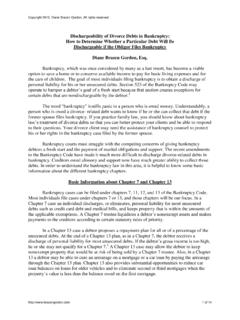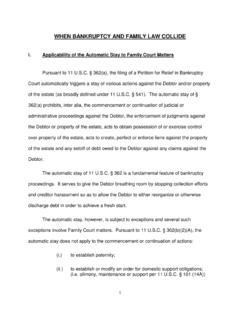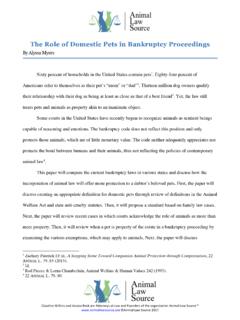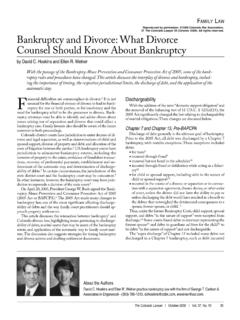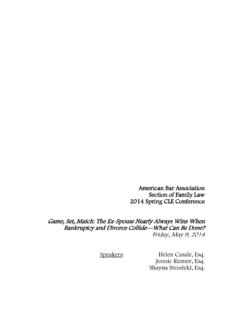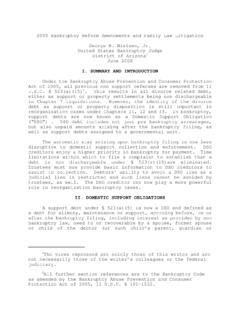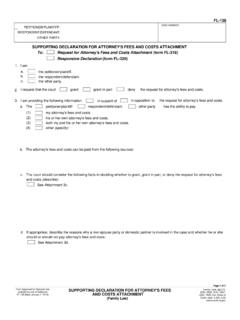Transcription of MINNESOTA CLE FAMILY LAW INSTITUTE 2012 ... - Larkin …
1 MINNESOTA CLE FAMILY LAW INSTITUTE 2012 THE INTERSECTION BETWEEN FAMILY LAW AND bankruptcy LAW Last Updated March, 2012 Materials by: Kenneth Corey-Edstrom e-mail: Larkin Hoffman Daly & Lindgren Ltd. 1500 Wells Fargo Plaza 7900 Xerxes Avenue South Bloomington, MINNESOTA 55431 (952) 835-3800 website: Additional Materials by Joani C. Moberg: e-mail: Henschel Moberg 100 Washington Avenue South Suite 1325 Minneapolis, MN 55401 (612) 326-6000 Website: 2012 Larkin Hoffman Daly & Lindgren. All Rights Reserved 1 TABLE OF CONTENTS I. WHAT IS bankruptcy .. 4 II. bankruptcy CHAPTERS .. 4 A. Chapter 7-Liquidation .. 4 B. Chapter 11 .. 5 C. Chapter 12 .. 5 D. Chapter 13 .. 5 III. STRUCTURE AND FUNCTIONING OF bankruptcy .. 5 A. The Estate .. 5 B. Venue .. 6 C. The bankruptcy Trustee.
2 6 1. Avoiding Unperfected Property Interests .. 7 2. Property of the Estate-Turnover of 8 3. Preferential Transfers .. 8 4. Fraudulent Transfers .. 8 5. Other Examples of Use of Avoiding Powers by Trustee to Obtain Assets .. 10 D. The Automatic Stay .. 11 1. Marital Law Exceptions to the Automatic Stay .. 11 2. Lifting the Automatic Stay .. 12 E. Discharge of Debts .. 13 1. Pre-Petition Debts 13 2. Exceptions to Discharge .. 14 3. Dischargeability of FAMILY Law-Related Debts in Chapter 7 Cases .. 14 4. Stripping of Exemptions as to Domestic Support Obligations, 11 522(c)(1).. 16 5. Filing A Proof Of Claim.. 17 IV. CHAPTER 13 .. 17 A. Differences between Chapter 7 and Chapter 13 .. 17 B. The Importance of the Chapter 13 Plan .. 17 C. Filing of Proof of Claim in Chapter 13 Case.
3 18 D. Non-Debtor Ex-Spouse Rights in Chapter 13 Cases .. 18 E. Section 1307(c) 11 .. 19 F. Misc. FAMILY Law Chapter 13 Issues .. 20 2012 Larkin Hoffman Daly & Lindgren. All Rights Reserved 2 V. bankruptcy FILINGS AND FAMILY LAW DECREES .. 20 A. Exemptions .. 20 1. Treatment of Child Support Payments Owed to the debtor in bankruptcy .. 20 2. Treatment of Property Settlements Owed to the debtor in bankruptcy .. 21 3. Treatment of Maintenance Awards Owed to the debtor in bankruptcy .. 21 VI. PROPERTY RIGHTS IN bankruptcy OF A NON-BANKRUPT SPOUSE .. 22 A. Use of State Property Law in bankruptcy -in General .. 22 B. Liability of a Spouse for the Other s Debts under MINNESOTA Law .. 22 C. Ownership of Property Prior to the Start of a Divorce .. 22 D. Interpretation of State Property Laws by bankruptcy Courts.
4 24 1. Joint bankruptcy Filings .. 24 2. Substantive Consolidation .. 24 3. The Confusing Issue of Who Owns What in bankruptcy Court .. 24 4. Interest of a MINNESOTA Spouse in Homestead Property .. 27 5. Marital Property Completed Divorce Prior to bankruptcy Filing .. 35 6. Farrey v. Sanderfoot .. 35 7. The bankruptcy Injunction .. 36 1. Coakley v. Coakley (superseded by 11 523(a)(15)).. 37 2. Stolp v. Stolp (superseded by 11 523(a)(15)).. 37 3. Cline v. Cline .. 37 4. Fast v. Fast .. 37 E. Dual Representation of Spouses in a Joint bankruptcy Where the Clients Plan to Seek a Divorce After the Completion of the bankruptcy .. 39 VII. WHEN SHOULD I FILE? PROS AND CONS OF FILING bankruptcy BEFORE THE DIVORCE AND VICE-VERSA .. 42 A. Advantages of Filing bankruptcy Prior to the Filing of the Divorce (Some Benefits Exist No Matter When the bankruptcy Is Filed).
5 42 1. The Automatic Stay.. 42 2. Discharge of Indebtedness.. 42 3. Lien Avoidance .. 43 4. Reaffirmation of Debt/Redemption of Liens .. 43 5. Avoidance of Later Turnover of Non-Exempt Property Interest .. 43 6. Chapter 13 Repayment of Long Term Debt/Lien Stripping of Underwater Mortgages .. 43 7. Chapter 13 - Payment of Taxes .. 44 8. Chapter 13 - Halting of Interest/Restructuring Joint Debt .. 44 9. Chapter 13 - Writing Down Secured Debt .. 44 10. Non-Discharge of Future Indebtedness .. 44 B. Disadvantages of Filing bankruptcy Prior to the Filing of the Divorce .. 44 1. Destruction of Credit .. 44 2. Liquidation of Assets .. 45 3. Loss of Exemptions by Owing Spouse .. 45 4. Fraudulent Transfer Recapture .. 45 5. Loss of Excess Homestead Exemption Under Kipp v. Sweno.
6 45 6. Job Concerns .. 45 7. Non-Marital Assets and Unbalanced Liabilities .. 46 2012 Larkin Hoffman Daly & Lindgren. All Rights Reserved 3 8. Familial Debt .. 46 APPENDIX 1 FORM FOR NOTICE OF 47 2012 Larkin Hoffman Daly & Lindgren. All Rights Reserved 4 I. WHAT IS bankruptcy bankruptcy law is statutory federal law authorized by the United States Constitution. The current bankruptcy law was first passed in 1978. The law was significantly changed in 1984, 1986, 1994 and 2005. The basics of the law, despite these changes, have remained constant. bankruptcy , at its heart, is a set of laws designed to provide for two things: Equitable treatment of all creditors; and A fresh start for those individuals or businesses who seek its protection. II. bankruptcy CHAPTERS bankruptcy law is divided into different statutory sections called Chapters.
7 Each Chapter is described below. A. Chapter 7-Liquidation Chapter 7 is what is commonly known as straight bankruptcy or liquidation. The Chapter 7 proceeding may be commenced by any person (individual, partnership, or corporation) except: (a) a railroad, (b) a domestic insurance company, bank, savings bank, cooperative bank, savings and loan association, homestead association, or credit union, or (c) a foreign insurance company, bank, savings bank, cooperative bank, savings and loan association, building and loan association, homestead association, or credit union, engaged in such in the United States. 11 109(b). The first time a creditor may know that its debtor is in bankruptcy is when they receive the bankruptcy Notice in the mail. It is important for a creditor to read the bankruptcy notice from cover to cover.
8 The notice is in small print but it contains important information such as: The date, time and place of the Meeting of creditors. The deadline to file Proofs of Claim if such a deadline has been established. The deadline to object to exemptions claimed by the debtor. The primary purposes of Chapter 7 liquidation proceedings is to give individual debtors , as well as corporate debtors , an orderly method of distributing their assets to creditors in a fair and equitable manner. This is generally referred as the equity or fairness policy of the bankruptcy Code. In addition to this equity policy, an additional purpose of a Chapter 7 is to give individual debtors a chance for a fresh start and an ability to begin life, in an economic sense anew. This policy does not apply to a corporation that is liquidating in either a Chapter 7 or liquidating through a Chapter 11 liquidating Plan and therefore, corporations in a Chapter 7 or in a liquidating Chapter 11 do not receive discharge for their debts.
9 In keeping with this fresh start policy, Congress and most states have made the policy decision that creditors should not be permitted to force liquidation of all an individual debtor s assets. 2012 Larkin Hoffman Daly & Lindgren. All Rights Reserved 5 Virtually all states protect the clothes on the debtor s back. This principle of exemption of assets from the claims of creditors has created much controversy since the adoption of the bankruptcy Reform Act of 1978. B. Chapter 11 Chapter 11 s primary purpose is to allow businesses or corporations in financial distress, to continue to operate while they reorganize or restructure their debts. An individual with an exceptionally complicated financial picture can also utilize Chapter 11. The framework and functioning of a Chapter 11 is beyond the scope of these materials.
10 The interaction of bankruptcy law and FAMILY law is the same in a Chapter 11 case as in a Chapter 7 case except that in an individual Chapter 11, the debtor acts as his or her own Trustee. C. Chapter 12 Chapter 12 is an addition to the Code specifically designed to offer relief to FAMILY Farmers. In many of its provisions, Chapter 12 is similar to Chapter 13. Its provisions and requirements are also beyond the scope of these materials. Suffice it to say, that Congress has enacted this special provision for the debt problems of farmers. Its provisions were passed during the agricultural crisis of the 1980s but were only made permanent in 2002. D. Chapter 13 Chapter 13 of the bankruptcy Code has entitled adjustment of the debts of an individual with regular income.
